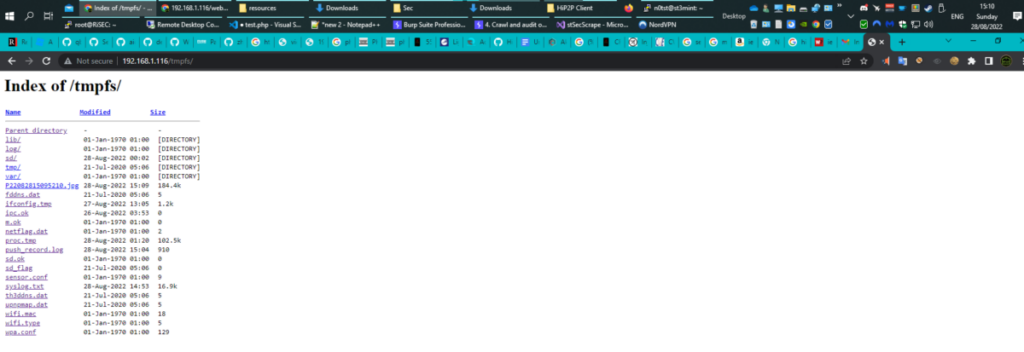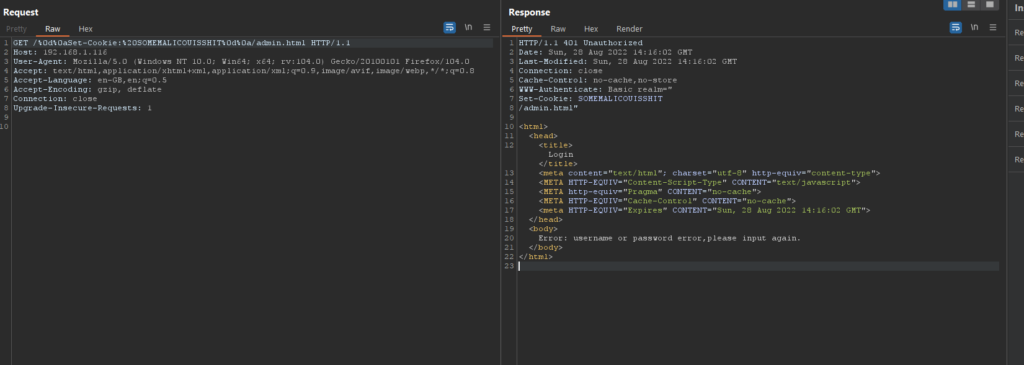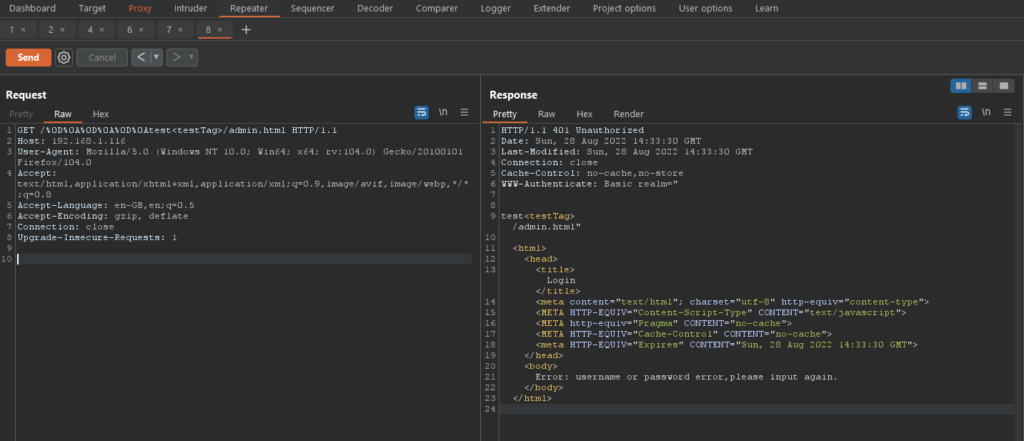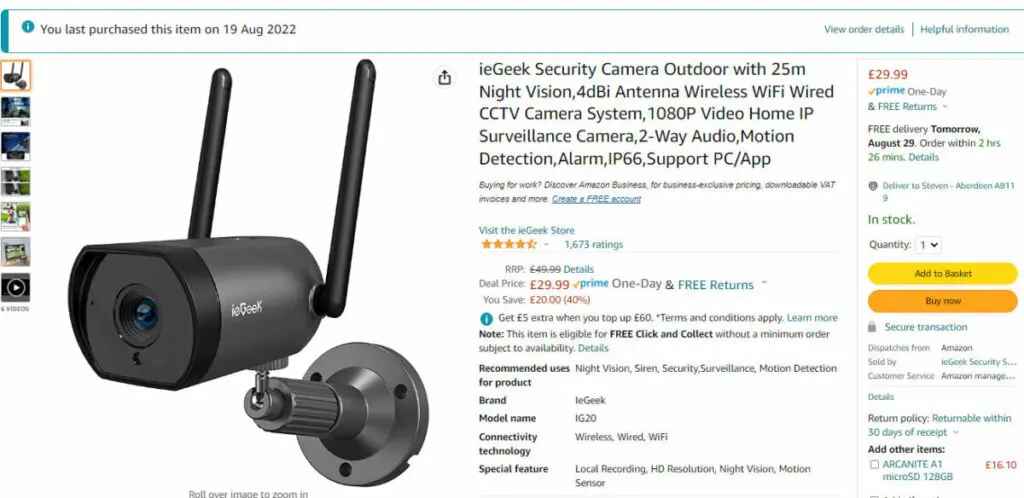Amazon’s “highly rated”, “recommended” ieGeek brand continues to present a number of security vulnerabilities.
ieGeek Security Vulnerabilities
On the 19th of Aug 2022 I set out to purchase a CCTV Camera from Amazon, I read over the reviews of the ieGeek IG20, and it seemed great, the value too. For just £29.99 I’d get myself a great looking CCTV Camera, packed full of features. It has night vision, Smartphone access, Motion Detection, Plug & Play, It’s waterproof and it can connect via WiFi or Ethernet. Great, I was sold. However, I failed to do any research on the brand specifically.
The camera arrived the following day, and later that day I got around to setting it up. I first noticed that on the back of the camera, there was a sticker with a UID printed, along with a Factory default Username & Password combination, consisting of admin/admin.
ieGeek IG20 Issues/Vulnerabilities
UID Weakness CWE-340 – CVE-2022-38970
The UID is predictable. The UID in our case will look like this: AAFF-123456-ABCDE – depending on the make and model.
- UID p1: Same 4 letters at the start.
- UID p2: 6 numbers at random in the middle.
- UID p3: 5 random letters at the end.
Evidently, having just this basic knowledge of the UID and using the default credentials, the camera feed could be accessed using the software provided by ieGeek from their website by testing each UID value. This can leave a number of IP cameras vulnerable to unauthorised viewing with the privacy of users at risk.
Below are some more vulnerable prefixes running the same vulnerable firmware.
| AAAA | AABB | AACC | AAES | AIPC |
| AAFF | BBBB | CAM | CAMERA | CCCC |
| DDDD | DEAA | EEEE | ELSA | ELSO |
| ESCM | ESN | ESS | EUA | EYE |
| FCARE | FDTAA | FFFF | FOUS | GCAM |
| GCMN | GGGG | GKW | HHHH | HRXJ |
| HSL | HVC | HWAA | HZD | HZDA |
| HZDB | HZDC | HZDN | HZDX | HZDY |
| HZDZ | IIII | ISRP | JWEV | MCI |
| MDI | MEIA | MMMM | MSE | MSI |
| MTE | NIP | NNNN | NTP | OBJ |
| PHP | PISR | POLI | PPCN | PPPP |
| PTP | QSHV | ROSS | SECRUI | SPCN |
| SSAA | SSSS | SURE | SXH | TTTT |
| UUUU | VIEW | VSTA | VSTB | VSTC |
| VSTD | VSTF | WCAM | WGKJ | WHI |
| WNR | WNS | WNV | WWWW | WXH |
| WXO | XCPTP | XHA | XLT | XWL |
| ZLD | ZZZZ | AVA |
Unauthenticated / Default auth access to camera stream via RTSP protocol CWE-284
By default, one can easily access the camera’s stream externally or internally depending on your router/network configuration, with our without means of Authentication.
- Zero Authentication: rtsp://+IP+/11
- Default Auth: rtsp://admin:admin@+IP+/11
Replace +IP+ with your local or external IP.
Here is a screenshot of the Default RTSP settings, requiring Zero authentication.

Default P2P Camera feed activated and sent to a server in plaintext CWE-284
The cloud function of the camera uses the P2P protocol to send and make requests back to a server based in China in plaintext. It was found that all connections back to this were made in plaintext regardless of protocol, this includes the viewing of the camera’s stream and control. HTTPS was not found to be implemented anywhere on the camera.
Access to files stored on the camera CWE-284
The following directories can be viewed using the default login:
- http://+IP+/tmpfs
- http://+IP+/js
- http://+IP+/lib
- http://+IP+/log
- http://+IP+/resources
- http://+IP+/sd
- http://+IP+/swfs

The number of links discovered showed that the SD card, log files and website front-end code were accessible from the web interface. This includes any footage that has been recorded by the device and stored on the external SD card.
I decided to check out shodan.io and searched for “hipcam realserver”. Shodan is a Google like database of Connected Devices, if you like. It produced 93,312 results of addresses that had port 554 exposed to the internet. As I browsed these I also discovered a number of addresses that also had Port 80 exposed, hosting the same ‘IP Camera’ front page with login. With what I have discovered it is possible for each of these devices to be accessed via default credentials, or if the admin credentials are changed, Using VLC player, I could potentially connect to each of these camera streams without the need to authenticate.

Admin Panel – Basic Authentication in use / Weak Password Requirements CWE-521 / CWE-287
When the camera is booted up, a web server is spawned and requires a login to gain access. Default credentials were then used to gain access and there was no setup to force change of the default password in place. Burpsuite caught this login process; the session was found to be using HTTP Basic Authentication to handle the username and password. The Base64 translates to admin:admin.

JavaScript injection (DOM-based) CWE-79
Data is read from document.cookie and passed to eval()
var strCookie=document.cookie;
var arrCookie=strCookie.split('; ');
var arr=arrCookie[i].split('=');
return unescape(arr[1]);
var cooktype=getcookie('cookmun');
var string = eval("'cgi-bin/hi3510/param.cgi?cmd=setimageattr&-image_type="+cooktype+"&-default=on'");Using various different methods of escaping. Stored XSS was also prevalent in many places within the admin panel that used user input. Example: FTP Upload settings.
HTTP Response Header Injection/Splitting CWE-644
The web application is also evidently vulnerable to HTTP response header injection, see PoC below. This also led me to discover i was able to break out of the response.
Your options for exploitation vary depending on the type of response you’re injected into and also where in the response you’re placed!

Here we’ve added a “malicious cookie” which will be set in the browser. As mentioned earlier i was also able to break into the body, or out of the headers through double CRLFs (%0d%0a%0d%0a) see below.

When user input is insecurely inserted into the headers of server responses, HTTP Header Injection vulnerabilities are created. They are based on the theory that an attacker can make the server generate a response that contains carriage-return and line-feed characters (or, respectively, %0D and %0A in their URI encoded forms), within the server response header, and/or that the attacker may be able to add specially created headers. Attacks like response splitting, session fixation, cross-site scripting, and malicious redirection are all possible using header injection.
Often, the injection of headers is not the main attack; rather, it is merely a method for accessing or exploiting another flaw. For instance, if a hacker is able to inject a payload through HTTP header injection, they may target a website that is susceptible to cross-site scripting in the Referer header or in a cookie value etc.
Device NMAP scan
Starting Nmap 7.80 ( https://nmap.org ) at 2022-08-28 00:42 BST
Nmap scan report for 192.168.1.116
Host is up (0.0088s latency).
Not shown: 996 closed ports
PORT STATE SERVICE
80/tcp open http Hipcam RealServer/V1.0
554/tcp open rtsp
1935/tcp open rtmp Real-Time Messaging Protocol
8080/tcp open http-proxy ONVIFservice
MAC X (Shenzhentong BO Weitechnology) SHENZHEN TONG BO WEI TECHNOLOGY Co.,LTD
Device type: general purpose
Running: Linux 2.6.X|3.X
OS CPE: cpe:/o:linux:linux_kernel:2.6 cpe:/o:linux:linux_kernel:3
OS details: Linux 2.6.32 - 3.10
Network Distance: 1 hop
Anyway, I decided enough is enough with this trash device and unplugged it from my network, packaged it back up and arranged a return with Amazon.
The Listing On Amazon


At the time of writing, the listing is still available, however, I reached out to Amazon and made them fully aware of everything, including my intention to publish this article, and they advised me that the product listing would be “temporarily” removed today, 28th Aug 2022, pending further Investigation.
The listing can be seen here [if still available]
It has to be worth noting, that there was an investigation by Which.co.uk see reference [3] in July 2021, that details a line of similar flaws, consequently, Amazon removed the said ieGeek branded camera from sale on its website. The which? investigation revealed another device from the same manufacturer can be easily hacked by cybercriminals.
The £40 camera, which was labelled Amazon’s Choice, had more than 8,500 reviews (as of June 22 2021), including 68% giving the full five stars.
If you own the ieGeek Security Outdoor Camera 1080p, you should change its default password immediately, or better still, stop using it.
https://www.which.co.uk/news/article/iegeek-security-camera-removed-from-sale-following-which-investigation-ajW4t0g7bnGj
So the question remains, why do Amazon allow Manufacturers to list products irrelevant of the manufacturer having been Flagged, and Delisted in the past? A better system needs to be in place. Yes, I understand there can be a new line of products/models but surely amazon should be seen to be doing more to prevent devices like this from appearing on their website. The privacy and security of their customers should be paramount.
Update 01 Sep 2022 – Product Still Listed On Amazon
We’ve noted that the product is still available to purchase on Amazon, despite us being told that it would be removed, pending an investigation. We figured we’d add a screenshot, just for clarity.
Here is the screenshot of a mail I received from the Amazon Representative on the 28th of August, this email states the item “may be temporarily unavailable”, which contradicts what she told me on the telephone. This email arrived in my mailbox very shortly after I had a call with the same lady, Roxy.

Update: 01 Sep 2022
We’ve been made aware of another article from Which.co.uk, this second article was published in late 2021, after the earlier-mentioned article. Their second write-up clearly paints a very different picture, one could easily say it’s misleading given what has been uncovered in this report. It has to be worth mentioning that my ieGeek device, and probably many many others, was still running the same vulnerability-ridden firmware that Which.co.uk spoke out against in their first write-up, as has been verified by the team here at risec and elsewhere. There was no obvious offer of any firmware upgrade, at least to my knowledge. Anyway, see some quotes from the second write-up below.
Millions of CamHi wireless cameras made more secure after hacking risk
Following a change by HiChip, all CamHi app devices when installed now must have their default password changed by the user.
HiChip has agreed to enforce a strong password policy, particularly blocking generic terms such as ‘password’ and ‘admin’.
For CamHi devices that are already set up in people’s homes, the app will remind them to change the default password and warn them if what they have chosen is weak
MISLEADING: https://www.which.co.uk/news/article/millions-of-camhi-wireless-cameras-made-more-secure-after-hacking-risk-aezzW2u2ELsl
We have reached out to Which.co.uk and have yet to receive any notable response.
Consumer Recommendations
If you value your privacy, and security as much as we do, please remove the device from service. It is simply unfit for purpose. If you bought it from Amazon, go and arrange a return as this device is in clear breach of their merchant conditions.
Research each device thoroughly before buying, and check it’s security reputation.
Be Aware: Endless numbers of IP cameras of other Brands also use the Hipcam RealServer service; I am unable to check the configuration of these devices specifically, but one would be led to believe they are all implemented similarly. Sadly, there doesn’t seem to be a method to warn anyone utilising these IP Cameras that they are exposed.
On a final note, take amazon’s reviews with a pinch of salt, and always do your homework. Next time your about to purchase a connected device, IoT(Internet-of-Things), do a quick google query, something like, “vulnerable BRAND” or “exploit BRAND”
Q&A
Are ieGeek cameras secure?
According to our research, and many others, ieGeek cameras are not secure. The devices they seem to be pushing out in 2022 are vulnerable in a number of ways as detailed in this article. Fundamentally, they lack proper encryption, and, are shipped to consumers riddled with security holes. One can only ask themselves, is it intentional? tldr; Given the research of the team here at RiSec, and research conducted elsewhere, we can categorically say ieGeek’s cameras are not secure in 2022.
What are the real risks of ieGeek cameras?
By using these devices that lack proper safety and security standards, your private data is at serious risk of being exposed, a bad actor may able to gain complete control of the cameras. This fundamentally opens up your entire network to further attack, making it much easier for a bad actor to reach an end goal.
Cheap CCTV cameras tend to be vulnerable to at least one of the following types of hacking:
- They have a weak default password and username setting, which can be easily discoverable. If the user doesn’t change those settings, it’s very easy for hackers to find their way into your camera control system, in every case, there is no prompt in the Admin panel when logging in, advising you to chase any password.
- They don’t encrypt your data so that your home router password input is un-encrypted and accessible to any cyber attacker, or themselves.., same applies with any SMTP email info provided, along with any FTP info provided to the device. By using the home router password, they can gain access to other devices on your home network, can monitor your Internet history and any stored data on connected devices.
- They let external users gain root access to the device itself, allowing hackers to take control, launch attacks from your device, and exfiltrate data.
Cheap CCTV Invites Outside Threats Into Your Home[4]
There are three main security issues you need to look for when buying your CCTV camera. Popular wireless security camera brands that are sold on online marketplaces like Amazon, but also eBay share common security flaws.
As a rule of thumb, brands that are not well-known outside of the online market should be avoided at all cost. Affordable CCTV solutions from Shenzhen-based factories in China sometimes fail to meet wireless safety standards.
Brands that have been tested for vulnerability and that you should avoid are the following; ieGeek, Sricam, SV3C, and Vstarcam. All come with a friendly price tag, but they are quick to join the list of CCTV cameras that put your privacy and security at risk.
Tested by a professional security lab, Context Information Security, “cheap CCTV cameras show that they fail to prioritise customers’ security even those that are bestsellers in online marketplaces”
[4]
Update: 21/09/2022 – After some back-and-forth correspondence with the vendor, ieGeek, they have disputed that the ieGeek IG20 is an insecure device, despite our evidence to the contrary, they also cited an invalid misleading Which.co.uk[5] post as seen above.
CVE Approved: CVE-2022-38970[6]
Update: 22/07/2023 – Product still widely available on Amazon.
Got some crazy story or thoughts on this article? We’d love to hear from you below!
Coming up next, I will be covering a Chinese “Mini-PC” that was shipped to me loaded with Malware.
Ciao, for now.
References
Cheap CCTV Sold With Known Vulnerabilities[4]
Stay informed of the latest Cybersecurity trends, threats and developments. Sign up for our Weekly Cybersecurity Newsletter Today.
Remember, CyberSecurity Starts With You!
- Globally, 30,000 websites are hacked daily.
- 64% of companies worldwide have experienced at least one form of a cyber attack.
- There were 20M breached records in March 2021.
- In 2020, ransomware cases grew by 150%.
- Email is responsible for around 94% of all malware.
- Every 39 seconds, there is a new attack somewhere on the web.
- An average of around 24,000 malicious mobile apps are blocked daily on the internet.




